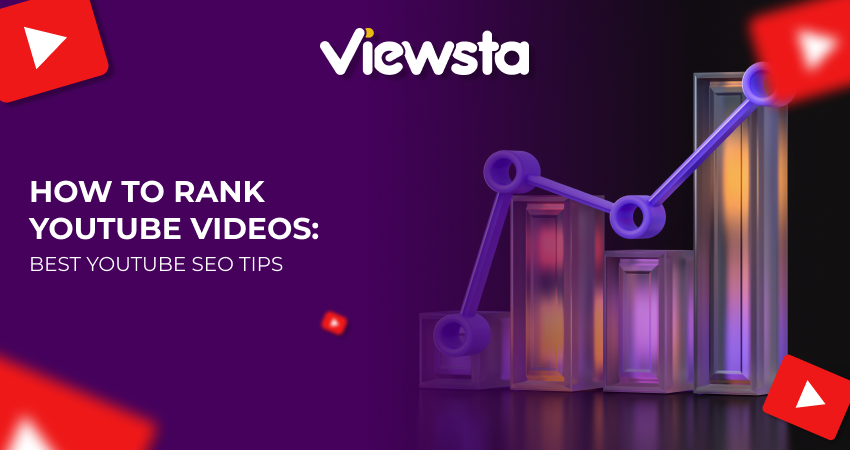
How to Create the Perfect Social Media Growth Plan for 2026
Read more

On YouTube, reaching a wider audience depends heavily on how well your videos rank in search results. Strong SEO (Search Engine Optimization) practices help your content appear where it matters most, right in front of the viewers who are searching for it. Below are key strategies to improve your video rankings and grow your channel.
Choosing the right keywords is the first step toward making your video easier to find. Focus on the words and phrases your audience uses when searching for content like yours. Use tools like Google Keyword Planner, TubeBuddy, or vidIQ to identify high-traffic, relevant search terms.
Start by thinking about topics related to your video. Then look at what successful creators in your niche are using for keywords. Relevance is essential—your keywords should reflect what your video actually covers. Accurate targeting helps attract the right viewers, improve watch time, and support better ranking.
Your title and description help YouTube understand your video and attract viewers. A strong title includes your main keyword and clearly communicates the topic. Keep it concise and make sure it matches the content.
In the description, provide a short summary in the first few lines and include secondary keywords naturally. Add any relevant links, calls to action, or timestamps below that. This not only helps with SEO but gives viewers useful context before they hit play.
Thumbnails play a key role in driving clicks. A clear, well-designed image that reflects the content helps set viewer expectations and boosts engagement.
Use bold colors, readable text, and visuals that match the video topic. Avoid clickbait, misleading thumbnails might draw initial views, but they can hurt retention and trust. Including expressive faces or consistent branding can also help build recognition and connection with your audience.
Tags and hashtags help YouTube categorize your content. Tags should reflect the core topic of your video, start with your main keyword, then add related terms.
Hashtags, which appear in the description or title, can help place your video among others on similar topics. When used thoughtfully, they can increase visibility and bring in new viewers interested in specific themes or trends.
The success of any video depends on how valuable and engaging it is. High-quality content keeps people watching, and that signals to YouTube that your video deserves to be recommended.
Focus on delivering clear, purposeful content that addresses your audience’s needs. Strong editing, structure, and pacing help keep viewers engaged. The longer people stay on your video, the more likely it is to appear in search results and recommendations.
Engagement—likes, comments, shares, and subscriptions—tells YouTube that your video is resonating with viewers. Encourage interaction with simple calls to action, like asking a question or inviting feedback in the comments.
Responding to comments and including your audience in future content helps build a stronger community. This interaction not only improves your video's performance but also helps grow long-term loyalty.
SEO tools like TubeBuddy and vidIQ provide insights into keyword trends, tags, and performance metrics. They also let you see what’s working for similar channels, helping you make more informed decisions.
Use YouTube Analytics to track key metrics like watch time, traffic sources, and viewer demographics. This data helps you adjust your strategy and better meet your audience’s expectations.
If you’re looking for more support, platforms like Viewsta offer SEO services and tools to boost exposure through optimization and targeted views.
Uploading on a regular schedule builds trust with your audience and shows YouTube that your channel is active. You don’t need to publish every day, just pick a pace you can maintain, whether that’s weekly, bi-weekly, or monthly.
Consistency helps build momentum over time, both in terms of viewer loyalty and algorithmic visibility. Just be sure not to sacrifice quality for frequency, each video should bring real value to your audience.
Use YouTube Analytics to evaluate your performance and guide your next steps. Look closely at watch time, retention rates, and click-through rates. These indicators help you understand what's working and where there’s room for improvement.
For example, if your video has strong click-through rates but poor retention, the content may not match viewer expectations. On the other hand, if viewers watch all the way through but discoverability is low, focus on improving your title, description, or thumbnail.
Reviewing this data regularly helps you adjust your strategy and grow with purpose.
Success on YouTube comes from a combination of solid SEO practices, consistent quality, and audience connection. By applying these strategies, you make it easier for people to find and engage with your content, helping your channel grow steadily over time. And you can always buy YouTube subscribers to increase your following.
What is YouTube SEO and why is it important?
YouTube SEO is the process of optimizing your content to improve its visibility in search results. It includes keyword targeting, metadata, viewer engagement, and more. With so much content being uploaded, SEO helps ensure your videos reach the right audience.
Why do thumbnails matter for SEO?
Thumbnails impact your video’s click-through rate, which is a ranking signal for YouTube. A strong thumbnail attracts attention and gives viewers a clear idea of what to expect, improving both visibility and retention.
What tools can help with YouTube SEO?
TubeBuddy, VidIQ, and Keyword Tool are popular options for keyword research and video optimization. YouTube Analytics is also essential for tracking performance and refining your content strategy.
How does YouTube Analytics support SEO?
Analytics shows how your videos are performing—metrics like watch time, audience retention, and traffic sources highlight what’s working. This insight helps you adjust titles, thumbnails, or content to improve discoverability and engagement.
Do tags and hashtags really help?
Yes, when used correctly. Tags help YouTube understand the content and context of your video, while hashtags help organize your content within trending topics or niches. Both can increase your video’s chances of being recommended.